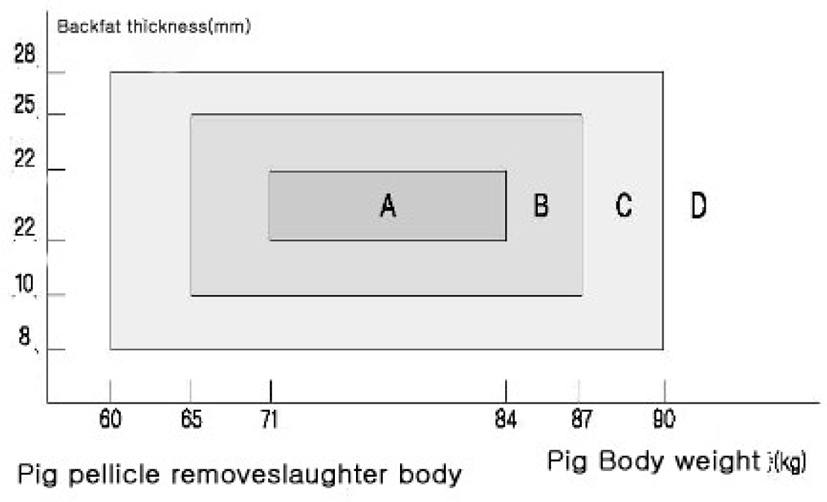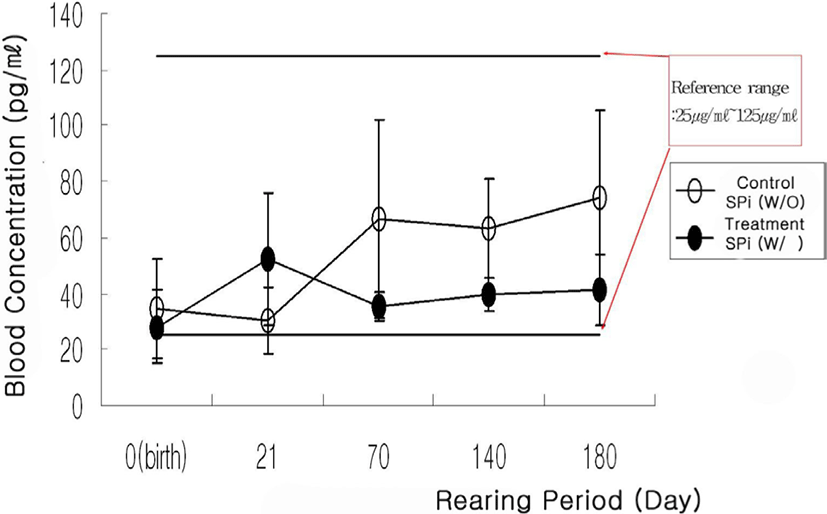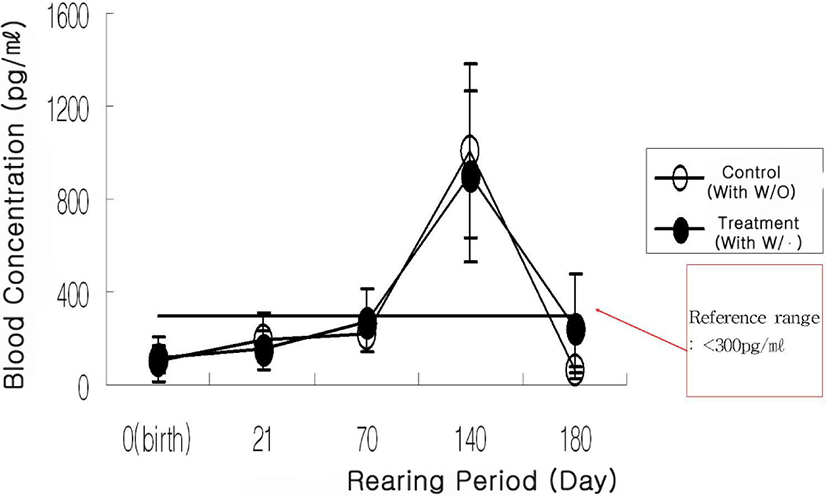INTRODUCTION
According to a report from the United States Department of Agriculture, Korea’s pork production volume in 2019 was one million ton which is the 11th largest in the world. It means that industry marketability related to pork reaches the global level and the number of pig slaughtering is apt to increase from 13,002,551 in 2006 to 13,805,588 in 2008 [1]. Pig meat export due to air infectious disease and infectious foot-and-mouth disease through other routes dropped from 33,070 ton in 2001 to 3,735 ton in 2005 but increased again to 8,249 ton and then sharply increased in February 2018 by 63 percent compared to January of 2019 [2]. It has been reported to help trigger exports to Japan and therefore, rise in domestic pork market is considered to continue [3].
Accordingly, it is imperative to establish a control plan for pigsty environment based on the basic data on airborne pollutants in pigsties to prevent disease and to have good health for livestock. Generally, three kinds of airborne pollutants in livestock houses are roughly classified for identification of airborne pollutants to provide fundamental data on pollution of air quality: gaseous, particulate, and biological pollutants.
Gaseous pollutants mainly originate when pig and chicken excreta stay in a swine house for a certain period and are dissolved by abhorrent microbes and additionally when pigs and chickens are breathing and ventilation system is running [4]. The NH3 and H2S concentration and emission in swine and hen houses are relatively high compared to other facilities and in particular, they would impede productivity of pigs and chickens and play hazardous substances in the workers’ bodies beyond occupational exposure level under the minimum ventilation rate applied to maintain proper indoor temperature when the outside temperature is extremely low in the winter [5].
Particulate pollutants include aerosols, particulates, and airborne particles. With extremely minute size of solid or liquid particles, aerosols are floating with gaseous substances in the air and particulates mean solid particles with 0.5 to 1,000 µm in diameter and all solid or liquid types of particles are generically called airborne particles [6,7]. There are some differences according to ventilator conditions or how to put feeds into swine and hen houses but it has been reported that particles of 5 µm and less account for 70 to 95 percent in total number of particles [8,9]. Therefore, it infers that people working in swine and hen houses are exposed to substantial amount of respirable particulates and have a possibility of respiratory disease at the same time. Similar to airborne microbes, biological pollutants adsorb to minute particulates, reach to alveolus of workers or livestock through breathing and cause respiratory disease such as pneumonia, asthma, bronchitis, rhinitis, etc. [10–12].
Lee et al. [13] studied the difference between intense and non-intense husbandry and stress hormones in pig with corresponding biological index and had the pig’s blood taken for measurement and analysis like blood and urine collecting. As a result, stress hormones such as hormones as cortisol, epinephrine, norepinephrine, etc have great influence on the health of pigs. Pigs for fattening up are more stressful than general hogs in a crowded place and corresponding stress hormones of pigs exceed normal reference values. Better results should have come out in stress hormones of pigs under the congested environment than those under the non-congested environment. However, stress hormones of pigs for fattening up appeared stable in a highly congested pigsty and there was little hormone production in pig due to wearisomeness by hardly moving around. In general, common results conflict with the hypothesis that the higher a pigsty is congested, the more produced stress hormones are. However, it considers sufficient fundamental data for this research to be investigated based on the authors’ finding.
According to the findings of Seong et al. [14], it might be clarified effectively to some extent that dietary MgSO4 supplement improves pork quality and restrict production of Pale, Soft and Exudative (PSE) pork characterized by its pallor, softness and low water binding capacity. However, it might be difficult to conclude the effectiveness due to insignificant results and another research might be required on health problems of pigs caused by dietary MgSO4 supplement.
However, the domestic case studies have been mainly conducted under poor conditions, which were made artificially rather than under breeding conditions in general farms. As a result, the productivity index of pigs is the mainstream of researches but those related basic data have been not sufficient so far. There are, for the most part, materials about productivity index of overseas pigs in a veterinary rather than environmental concept [15–17]. Moreover, a variety of researches have utilized data on stress hormones playing an important role in productivity index of pigs since there are no materials affecting it y improving air quality in swine houses [18–20].
Therefore, when pig productivity increases due to a decrease in stress hormones by improving air quality in swine houses, then the pork quality is guaranteed. This study was performed to evaluate the effect of the air cleaner on pork quality after final shipment by operating the air cleaner during pig breeding.
MATERIALS AND METHODS
The manufacture of air cleaner applied to this study was intended to reduce air pollutants emitted from pig houses. Its operation mechanism is based on a combination of filtration by dry filter and eradication by plasma ion emission. The former and the latter equipment were installed to an air cleaner for lessening gaseous and particulate pollutants and biological pollutants, respectively. It is a wall-typed air cleaner and its dimension is as follows: 2 m (L) × 0.5 m (W) × 0.5 m (H). As a result of preliminary test before the experiment setup, anion emission from this air cleaner was maintained to mean 30,000 no. cc−1. Although there is little information regarding measurements comparing the air entering and exiting the plasma air cleaner, degradation efficiency of approximately 5%–15% for volatile organic compounds was reported by current previous study [21].
Experimental swine house (4.5 m × 12.0 m × 3.0 m) selected in this study was located at the National Institute of Animal Science, Korea. It had two pig housing rooms and 10 pens (L: 6.0 m × W: 5.2 m × H: 0.5 m) in each room installed with open partitions and constructed from galvanized steel spindles 3.7 cm apart, on either side of a 1.1m wide central alley. A 1.3 m deep manure pit was under a partially slatted and concrete floor with a pit surface area of 22.8 m2. Inside, the building was insulated with 0.8 mm steel plate and 50 mm styrofoam in the side walls and ceiling. The ventilation mode in the pig building is a negative pressure system equipped in the wall. The 70 cm-diameter wall exhaust fan in the compartment removed the stale air. Fundamentally, an automatic controller adjusted the wall ventilation rate based on the optimal room temperature (15°C–25°C) and relative humidity (40%–70%) for growing pig well. The layout of the experimental housing is well shown in Fig. 1.
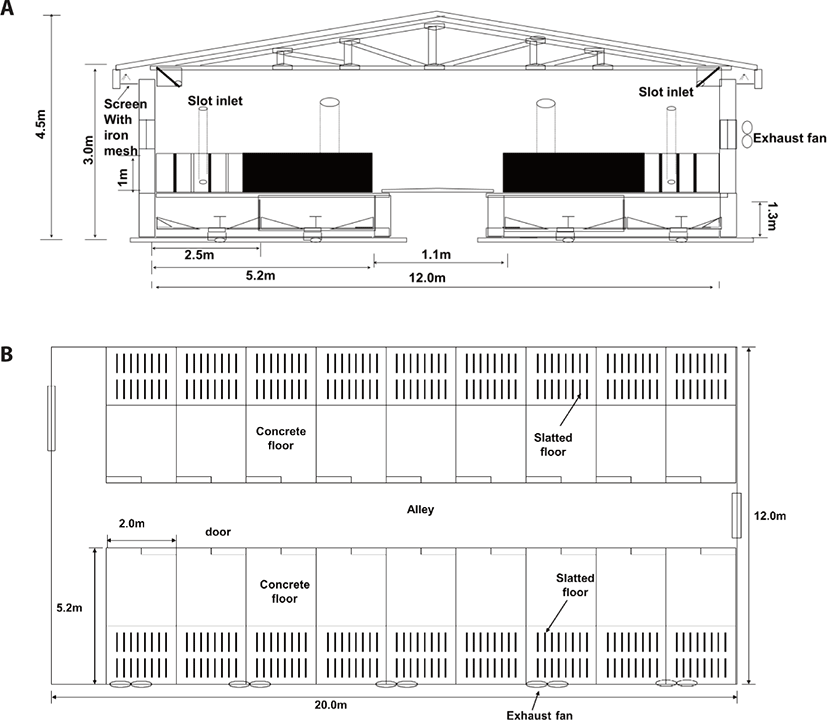
Fifteen crossbred (Landrace × Yorkshire × Duroc) growing pigs with the approximate average weight of 50 kg were housed in each pen. All pigs were feeder-fed at 16% protein corn-soybean meal-based diet that satisfied the National Research Council (NRC) nutrient requirements. The feeders were manually filled once every two days. Pigs were given ad libitum access to feed and water supplied by a nipple.
The experimental procedure was approved by the Institutional Animal Care and Use Committee at Seoul National University of Science & Technology (approval No. : 2021-0002). The stress hormones of pigs between the control room (without air cleaner) and the treatment room (with air cleaner) has been monitored for six months according to pig’s rearing stage: 0 day (farrowing), 21st day (farrowing–weaning), 70th day (weaning–nursery), 140th day (nursery–growing), and 180th day (growing–fattening). As shown in Table 1, a total of four units of air cleaners were installed in the wall per each pen in the treatment room. The blood collection for evaluating a contribution of air cleaner to pig’s stress was conducted for 10 pigs of total 50 pigs reared in each room, selected randomly and marked with oil-based pen at the experiment initiation, in the control and treatment room. Finally, the test for examining the quality and safety of pork was performed for the marked pigs shipped after fattening stage.
The radio-immuno assay (RIA) was applied to analyze the level of cortisol. Its test principle is as follow. The reaction is induced by putting a standard substance and a serum sample in a polypropylene tube with an immobilized antibody attached. Here, coated 125 I-labeled cortisol is added to separate the antibody bound fraction into radiolabeled cortisol. Finally, the remaining unbound form except for the material completely bound with antibody-specimen-125 I-labeled cortisol is removed and the concentration of cortisol by measuring on a gamma counter is analyzed.
The high proficient liquid chromatography (HPLC) was applied to analyze the levels of epinephrine and norepinephrine. Its test principle is as follows. After removing the protein from the serum sample with perchloric acid, acid-treated alumina is added to the mixture of the upper layer collected by centrifugation, the internal standard and its buffer to adsorb catecholamine and internal standard in plasma. When the extracted eluent is injected into a C18 reverse phase column and an ion pair forming reagent is added to the buffering system with an organic phase of about 4% and used as a mobile phase, norepinephrine, epinephrine, dopamine, and internal standard substances are separated and detected finally with an electrochemical detector (ECD).
The indices for evaluating pork quality adopted in this study are meat color, intermuscular fat, and quality class. Grade decision of pork carcass by meat color is based on hot or cold carcasses considering workplaces and processing plants. Grade decision of hot pork carcass could be applied by a person or machine. However, if it were impossible to decide grade by machine due to the mechanical breakdown, grade shall be determined by a qualified person according to Clause 1, Art. 9 (Livestock Industry Act, 2009). The lowest grade in the first decision with two judgements shall be the final. Grade by meat color is determined by ultrasonic machine, Ultraform a-mode.
Pig backbone thickness is the thickness between the half point of latissimus dorsi in sections of thoracic spine 4 to 5 or 5 to 6 and cutaneous trunci. Back fat thickness based on the standard for grade decision by an inspector is determined by the mean value of two back fat lengths with mm unit: one length between the last backbone on the half of the left carcass and the 1st hucklebone and the other length between the 11th and the 12th backbone. Back fat thickness and rib loin diameter based on the standard for grade decision by machine is measured by mm unit when the ultrasonic instrument (Ultraform, A-mode) adheres closely to the surface of the carcass at the point of 6 cm away from the point between the 12th and 13th backbone on the half of the left carcass to the abdomen direction. Yield-measured based on the standard for grade decision by machine, back fat thickness, and rib loin diameter are calculated by the following formula. The quality class of pork is determined according to the matrix of Table 2 and the grade is estimated considering relation between weight and back fat thickness of carcasses as shown in Fig. 2.
| Division | Class | ||||
|---|---|---|---|---|---|
| 1+ | 1 | 2 | 3 | Others | |
| Standard rank | |||||
| A | 1 + A | 1A | 2A | 3A | |
| B | 1 + B | 1B | 2B | 3B | |
| C | 1 + C | 1C | 2C | 3C | |
| D | 1 + D | 1D | 2D | 3D | |
| Others | E | ||||
Students’ t-test, by means of SAS package program (SAS 2010, SAS Institute, Cary, NC, USA), was executed to significantly compare the difference of stress hormones and pork quality between the control (housing room without air cleaner) and the treatment (housing room with air cleaner). Based on auction cost per 1 kg of pork suggested by Animal Products Grading Service (APGS), the benefit analysis was conducted regarding pigs shipped from the control and the treatment.
RESULTS AND DISCUSSION
Fig. 3 shows the fluctuation of cortisol concentration in blood of ten pigs selected randomly in the control room and the treatment room according to pig’s rearing step. Regardless of control and treatment, the mean levels of cortisol in all the pig’s rearing steps were included in the reference range (25–125 μg/mL). Except for weaning step, mean cortisol concentration were higher in the control room than the treatment room. This finding can be explained by the previous report [22] that the high level of cortisol in pig’s blood caused the reduction of pig’s body weight gain.
Research is still conducted for the negative effects of stress hormones on physical functions such as reproductive and immune function, perception, and metabolism [23,24]. In particular, research has been intensively conducted on the correlation between stress and changes of immune system like increase in susceptibility to diseases according to immunodeficiency by stress [25]. When pigs get stressful, their bodies have to produce energy to confront such threats. The sympathetic system of pigs starts to work and such hormones as epinephrine, norepinephrine, and steroid are produced in the adrenal glands. Here, the cortisol is a corticosteroid hormone produced by the adrenal cortex that is part of the adrenal gland and it increases blood flow and gets rapid pulses, breathing, and sensitive sensory organs when danger like stress threatens. Subsequently, hypertension, chronic fatigue, headache, and flu by weak immune system follow.
Fig. 4 shows the fluctuation of epinephrine concentration in blood of ten pigs selected randomly in the control room and the treatment room according to pig’s rearing step. Regardless of control and treatment, the mean levels of epinephrine were sustained below the reference range (300 pg/mL) except for the growing step (140th day). The finding that an epinephrine concentration exceeded the reference range in both control and treatment rooms would be reasoned by acute stress or other environmental condition and not by the effect of air cleaners. Bart [26] proved that drastic increment of epinephrine concentration in blood and body weight gain occurred simultaneously in pig’s growing period, which indicates 70 to 140 days after birth. This report was consistent with the finding of this study. In general, however, it is recognized that there is negative correlation between body weight gain and stress hormones. Thus, it is inevitable that many studies be performed to clearly determine their association.
Epinephrine, also referred to as adrenaline, is a hormone produced in the adrenal medulla and it increases response of the nervous system and hormones. It is produced in the ending of the sympathetic nerve system by electrical stimuli from the central nerve and delivers the stimuli to the muscle. Under stress, which is the state when the sympathetic system is stimulated, epinephrine expands blood vessels in the brain or muscles on the bones and make the muscle deal with stress. At the same time, epinephrine narrows the blood vessels and decreases response to digestive activity, which is not directly related to stress. Therefore, the heart beat is getting rapid, and capillary vessels are contracted, and the blood pressure increases when the sympathetic system is stimulated. Acetylcholine plays such a role in the parasympathetic nerve system or motor nerve system.
Fig. 5 shows the fluctuation of norepinephrine concentration in the blood of ten pigs selected randomly in the control room and the treatment room according to pig’s rearing step. Like a case of epinephrine, the mean levels of norepinephrine in both control and treatment rooms were sustained below the reference range (800 pg/mL) except for the growing step (140th day). The reason that sudden increment of norepinephrine occurred in growing step would be identical to the case of epinephrine based on fact that they are acute stress hormones. On the 140th day, both treatment room and control room showed high concentration of norepinephrine, which is presumed to have been stressed by external conditions rather than the effect of air cleaner.
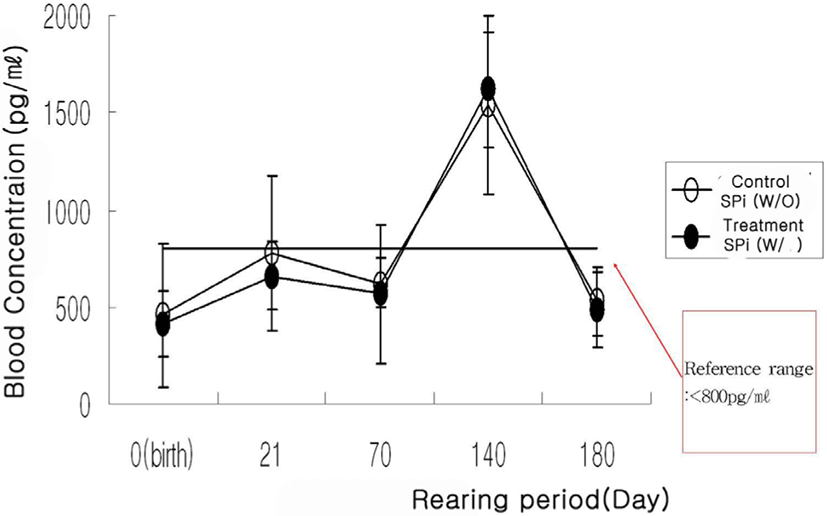
Norepinephrine, also referred to as noradrenaline, is a hormone produced with epinephrine in the adrenal medulla intimately connected with the sympathetic division of the autonomic nervous system. As a stimulator in the nerve system, norepinephrine determines aggressive characteristics of pigs. To sum up, response hormones to stress are epinephrine and norepinephrine produced in the adrenal medulla and glucocorticoid produced in the adrenal cortex [27]. In particular, epinephrine and norepinephrine are known as substances in response to stress by increasing heart rate, making wide bronchi and promoting dissolution of glycogen into glucose. Glucocorticoid prevents body function from lowering due to stress by changing fat or protein into glucose, decreasing edema and pain, and responding to anti-inflammatory effects. However, glucocorticoid has a function of immunosuppression such as T cell differentiation and suppression when it is continuously overproduced [28]. Changes in the serum levels of those hormones’ response to stress have been referred as a marker in evaluating how much stress each individual gets.
As indicated in Table 3, the mean meat colors of each ten pigs shipped from the treatment room and the control room were 4.21 ± 0.75 and 4.18 ± 0.64, respectively. In case of class based on meat color, however, both the treatment and the control rooms showed same class level (1+ class: 8 heads, 1 class: 2 heads). It was proved, therefore, that there was little difference on meat color of pork between the pigs in treatment and control rooms. This result would be explained by two aspects. One is that 20 heads selected for investigation is relatively smaller compared to 120 heads reared in this study. The other is that the effect of air cleaner on improvement of meat color cannot be examined easily because the experimental site of this study would be managed better than other general pig building.
| Treatment (with air cleaner) | Control (without air cleaner) | |
|---|---|---|
| N | 10 | 10 |
| Meat color | 4.21 | 4.18 |
| SD | 0.75 | 0.64 |
| 1+ class (No. 4 & 5) | 8 | 8 |
| 1 class (No. 3 & 6) | 2 | 2 |
| 2 class (No. 2 & 7) | - | - |
As indicated in Table 4, the mean thicknesses of intermuscular fat of each ten pigs shipped from the treatment room and the control room were 22.34 ± 6.39 mm and 16.97 ± 5.48 mm, respectively. In case of class based on thickness of intermuscular fat, the treatment room showed 1 head for A class, 5 heads for B class, and 4 heads for C class while the control room showed 2 heads for A class, 3 heads for B class, and 5 heads for C class. Although the pigs in the control room had improvement effect than those in the treatment room in terms of head number, mean value (22.34 mm) of the treatment was rather near to 22mm corresponding to A class in terms of average thickness of intermuscular fat.
| Treatment (with air cleaner) | Control (without air cleaner) | |
|---|---|---|
| N | 10 | 10 |
| Intermuscular fat (mm) | 22.34 | 16.97 |
| SD | 6.39 | 5.48 |
| A class (22 mm) | 1 | 2 |
| B class (10–25 mm) | 5 | 3 |
| C class (8–28 mm) | 4 | 5 |
However, both the treatment and the control rooms showed same class level (1+ class: 8 heads, 1 class: 2 heads). It was proved, therefore, that there was little difference of meat color of pork between the pigs in the treatment and the control rooms. This result would be explained by two aspects. One is that 20 heads selected for investigation is relatively smaller compared to 120 heads reared in this study. The other is that the effect of air cleaner on improvement of meat color cannot be examined easily because the experimental site of this study would be managed better than other general pig houses. Thus, additional research should be performed on a larger number of pigs to clearly elucidate effect of air cleaner on improvement of thickness of intermuscular fat.
Table 5 presents the mean final carcass grade of each ten pigs shipped from the treatment room and the control room. The treatment room showed 1 head for A grade, 6 heads for B grade, 1 head for C grade, and 1 head for D grade. The control room showed 2 heads for A grade, 5 heads for B grade, 2 heads for C grade, and 1 head for D grade. As a result, there was generally little difference of final carcass grade between the pigs in the treatment and control rooms. Like a case of thickness of intermuscular fat, thus, additional research should be performed on a larger number of pigs to clearly elucidate the effects of air cleaner on improvement of final carcass grade.
| Treatment (with air cleaner) | Control (without air cleaner) | |
|---|---|---|
| N | 10 | 10 |
| A grade | 1 | 2 |
| B grade | 6 | 5 |
| C grade | 2 | 2 |
| D grade | 1 | 1 |
The benefit analysis of pork shipped between the treatment and control rooms was performed based on auction price corresponding to A class of the pigs’ forwarding day (February 24, 2019) presented by APGS of Korea. Table 6 presents the calculated result regarding the benefit analysis of pigs shipped from treatment room and control room. Based on the calculated benefit amount ($51.34 per head), it is predicted that the farm rearing 1,000 pigs during one year’s management will be able to obtain the following benefit amount.
As a result, it is estimated that this farm shows a benefit of about $100,000. However, careful interpretation related to this estimated analysis result is necessary because only a small sample size (15 heads) compared to a total of 60 heads was investigated in the study. Thus, comprehensive review of various factors, which would affect the benefit-analysis should be considered in the further study.

